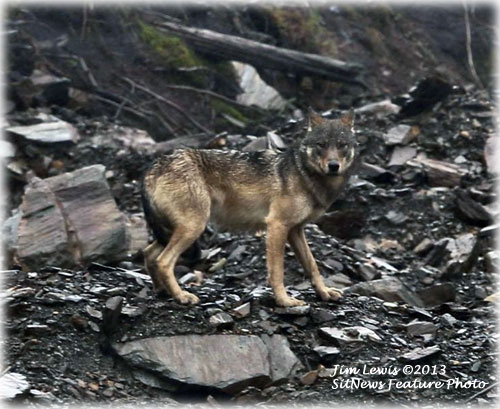
Feds ESA status review for SE Alaska’s Alexander Archipelago wolves 2 years overdue
November 13, 2013
According to these two conservation & advocacy groups, a status review may lead to listing these wolves as threatened or endangered. Quoting a news release, "during the delay the situation of these unique forest wolves has dramatically worsened, largely because of large-scale logging of old-growth trees on Prince of Wales Island in the Tongass National Forest."
Revilla Island: Wolf
The Center and Greenpeace petitioned to protect what they assert is a unique Alaska subspecies of gray wolf under the Endangered Species Act in August 2011. The agency is required to make an initial finding within 90 days about whether protections may be warranted — but two years later the U.S. Fish & Wildlife Service has still not acted say the petitioners. (Correction) The Alexander Archipelago wolves are not considered a unique species. According to information on the Alaska Department of Fish & Game's website, the Alexander Archipelago wolf found in Southeast Alaska is a subspecies of the gray or timber wolf. Based on common cranial characteristics, the Alexander Archipelago wolf was at one time considered by early taxonomists to be a distinct subspecies. However, recent taxonomic work suggests that these wolves may have originated from a larger subspecific group (C. l. nubilus) that at one time inhabited most of the contiguous Western United States. Earlier this fall the Forest Service, in response to an appeal by the Center for Biological Diversity, Greenpeace and three allied organizations, halted the Big Thorne timber sale in the Tongass National Forest so the Forest Service could reconsider the sale’s impact on the Alexander Archipelago wolves. The decision was prompted by an expert declaration in the groups’ appeal by preeminent Alexander Archipelago wolf biologist and former Alaska Department of Fish & Game Biologist Dr. David Person. Person concluded that “the Big Thorne timber sale, if implemented, represents the final straw that will break the back of a sustainable wolf-deer predator-prey ecological community on Prince of Wales Island.” According to Person, the Big Thorne project will log the last remaining high-quality winter range in the central part of the island for deer - the wolves’ primary prey - diminishing the wolf population. Logging elsewhere on the island, much of it on weakly regulated state and private forestland, will have a similar effect. The island’s predator-prey system, which includes hunters, will likely collapse; with less meat on the table in rural communities there will be “immense public and political pressure to kill wolves and bears.” “This situation of an impoverished prey-base compounded by the persecution of wolves because of the diminished deer population will put wolves in a double jeopardy of extinction on the island, and the Big Thorne project is a major factor in that reality,” said Greenpeace forest campaigner Larry Edwards. “Dr. Person points out that wolf populations on Prince of Wales have declined precipitously and already face the possibility of extinction there.” The Center for Biological Diversity and Greenpeace assert that the wolves on Prince of Wales and its associated islands are genetically distinct from other Tongass wolves saying the science shows that Prince of Wales and its associated islands constitutes a significant portion of the Alexander Archipelago wolf’s range, meaning that threats to wolves on Prince of Wales Island can necessitate the Endangered Species Act listing of the wolves. Since the 2011 petition to protect the wolves, the population on Prince of Wales has declined significantly. According to Person, there were 45 to 50 wolves in the Big Thorne timber sale area, in north-central Prince of Wales, in the mid-1990s. By 2013 he was able to find evidence of only six or seven wolves there; he estimated that the population declined by about 80 percent during the winter of 2012-2013 alone. Almost all of those wolves were killed by people, both legally and illegally, and access on the abundant logging roads enables these unsustainable death rates. The 90-day finding is the first in a series of required decisions to be made by the Fish and Wildlife Service. According to the Center for Biological Diversity & Greenpeace, such findings simply determine whether the petition presents sufficient information to warrant further consideration and thus require few agency resources. “There’s no reason this finding should take two years. Indeed we’ve heard it's been finished and sitting in Washington for months,” Noblin said. “Politics are what's holding up protection for these very imperiled wolves. The agency has repeatedly promised to make 90-day findings in the absence of litigation, and we've been more than patient in waiting two years, but we can't wait much longer.”
Edited by Mary Kauffman, SitNews
Sources of News:
E-mail your news &
photos to editor@sitnews.us
|
||
